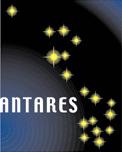White Dwarfs as Dark Matter?
Our Milky Way is a typical
spiral galaxy containing a rapidly disk of stars; like all known
spirals, measurements of its
rotation to be
much heavier than it appears. It seems to be embedded in very large
amounts of "
dark matter ".
One
solution to this so-called "dark matter problem" would be that
there are a lot of very dim stars out there which we have yet to detect
with our telescopes.
There are two types of star
which would fit the bill --- the so-called red dwarfs and the white
dwarfs. Both types of star are a little less
massive than the Sun, but are very much fainter; even at modest
distances from the Earth, they become very difficult to detect. Are
there huge numbers of them floating out there?
When the
Hubble Space Telescope was launched, one of its tasks was to look for
such stars; they would be so faint that seeing them with regular
ground-based telescopes is too difficult; only the superior resolution
of space allows one to tell the difference between
very faint stars and the very much more numerous faint galaxies. We
found in 1996 that the number of red dwarfs in images taken
with the Space Telescope is very small --- much smaller than needed to
explain the dark matter problem. So that ruled out red dwarfs.
Now this question has been
readdressed in recent work by the
DARKSTAR
research team.
Chris
Flynn and Janne Holopainen of
Tuorla Observatory and Johan Holmberg of Lund Observatory have
looked at the other possibility, the so-called white dwarf stars. White
dwarfs are stellar remnants; they are left over after a star has used
up its initial supply of Hydrogen fuel ; the Sun will become a white
dwarf in the far distant future.
The team created a model of
the distribution of the low-mass stars around the Sun, including the
colours, luminosities and space motions of the stars. They compared
their model to two very large surveys of the fastest moving and
faintest detectible stars on the sky. Such stars are good candidates
for the dark matter; firstly, whatever the dark matter is made of, it
is expected to be moving rapidly (if it
were not, its own gravity would pull it into the center of the galaxy)
: secondly, the stars are intrinsically dim.
The team concluded that,
although a few quite interesting stars have turned up in the two
biggest surveys to date, there are certainly not enough to explain the
dark matter component of the galaxy. But there is still hope for
white dwarfs; they need only be a bit dimmer than the limits of the
existing surveys to have been missed. New large surveys are being
planned and may yet find them, if they are there.
The research has been
published in the Monthly Notices of the Royal Astronomical Society.
Flynn, Holopainen and Holmberg, MNRAS 339, 81 (2003)
